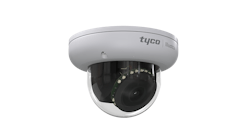The Benefits of Deploying Security Cameras at Airports
Lizzi Goldmeier is the director of marketing for BriefCam, a leader in video analytics technology that enables people, companies and communities to best utilize their video surveillance content. Goldmeier is responsible for BriefCam’s corporate communications strategy, helping increase awareness of BriefCam’s intelligent video analytics solutions for accelerating investigations, increasing situational awareness and enhancing operational intelligence.
Goldmeier spoke with AviationPros about the benefits airports can achieve by deploying the latest security camera technology.
AviationPros: What information do security cameras catch that other methods miss when addressing the passenger experience in a terminal?
Lizzi Goldmeier: Security cameras become a much more powerful tool when video content analytics are applied. This technology leverages existing video surveillance networks to derive searchable, actionable and quantifiable intelligence from live or recorded video content. It is designed to work in tandem with human personnel, increasing overall efficiency and decreasing human error and limitations. By deploying video analytics, airport security can reduce time spent on reviewing evidence in an investigation, dedicate fewer investigators to video review, detect and identify objects that might be overlooked or invisible to the human eye, and structure unstructured video into analyzable data that can be visualized and used for deriving operational insights.
Intelligent video surveillance isn’t only for security, though. It can also help airports optimize the passenger experience by visualizing passenger traffic and activity in terminals and checkpoints. By monitoring and analyzing building occupancy data, they can adequately prepare for expected crowds and prevent traffic bottlenecks. Airports can also uncover retail trends at stores and leverage business intelligence to drive decision-making across business groups, from law enforcement and security teams to marketing, merchandising and property management.
Since creating a safe, efficient passenger experience is the priority for airports, implementing data-driven decision-making is key. Video data can become an important and impactful tool for uncovering insights and developing strategy.
AVP: What types of camera hardware/intelligence is necessary to properly use them for both security and monitoring ongoing operations inside the terminal?
LG: Although video surveillance is traditionally regarded as a security solution, the introduction of video analytics technology expands the impactful applications for video data, which is why we are now seeing a huge upward trend in video analytics for operations and business intelligence use cases. Video analytics is a vehicle for optimization across a business, enabling an organization to leverage existing video surveillance technology for increased impact. For example, comprehensive video analytics solutions can uncover critical insights by visualizing activity and driving strategic decision-making. This, in turn, enables businesses to enhance customer experiences and optimize operational efficiencies. For example, airports can improve throughput at various airport checkpoints by tracking occupancy and traffic data over time. When this kind of intelligence can be accessed and utilized by every department – from security to operations and beyond – airports can easily increase the ROI for their video surveillance investments.
While the industry is understandably excited about the intelligence capabilities for video analytics, it is important to reinforce that they are also the foundation for successful airport security. Video analytics empower security operators to understand incidents post-event and effectively investigate suspicious activity by accelerating video review. While traditional video investigation methods take time, AI-based video analytics technology identifies, classifies and indexes objects in video, so it can be easily and quickly searched and filtered to pinpoint relevant evidence. The technology thus enables security and law enforcement to carefully review incidents in their immediate aftermath.
Additionally, video analytics increase situational awareness so security operators can proactively respond to developing changes in the environment. By triggering real-time, rule-based alerts based on specific criteria or behaviors that can be detected in video – such as loitering near sensitive areas or secured entrances at an airport – relevant authorities can be notified, assess each situation and make real-time decisions about responding to keep travelers and property protected in the event of a threat.
AVP: How does an airport set a plan for using them for this information?
LG: Since every organization is different, each must define its own best practices for data analysis and application, information security, and setting goals for technology investments. Video analysis provides an additional data source that can be evaluated alone or aggregated with other insights to draw correlations, identify gaps and make intelligent decisions.
Technology vendors can support airport management in determining goals and best practices for video analytics use so that end users get the most value out of the solution.
AVP: What setup do they need to consider for either the cameras themselves or back-end infrastructure to collect and sort data?
LG: Video analytics is a software solution; however, to enable video processing, solution architects need to plan around complex hardware requirements. For many deployments, the primary hardware investment is the cameras, making camera type a key consideration for the solution scope. Video resolution, bitrate and frame rate will also factor into the recommended supporting hardware for a video analysis integration. In addition, video processing requirements are decided based on how much real-time or on-demand processing an airport needs, which in turn will vary the other hardware investments required to provide that service.
Lastly, airports need to consider ease of use, which has significant impact on collecting and utilizing data provided by the video analytics. These solutions are impactful, but if they are too complicated for airport staff to utilize, then the investment is wasted.
AVP: Can camera AI (Artificial Intelligence) be trained to find more operational/passenger experience flags? How do they determine these types of measures to train the cameras for certain events?
LG: AI-powered video analytics software identifies, classifies and indexes objects in surveillance video. The extracted and categorized data becomes searchable, actionable and quantifiable, meaning that an airport organization can leverage the software to search, alert on and visualize video data based on extensive filtering. By adopting a comprehensive and extensible video analytics platform, airports can leverage these robust capabilities to meet unique and evolving needs across their organization.
AVP: How should they process this information? Is it a better real-time tool, or is it better served for long-term monitoring of operations and passenger experience?
LG: When using a comprehensive solution, video analytics supports both real-time needs while also supporting an airport’s need for long-term data to improve operations and the passenger experience. This combination provides unmatched value across the entire airport ecosystem.
Real-time video processing enables airport personnel to proactively respond to notifications based on the rules that they define (occupancy limits, passengers venturing into off-limits areas, etc.). They can also receive continuous real-time data for monitoring operations such as crowd movement, staff management and construction. On-demand video processing is just as powerful in a different way. It allows personnel to pinpoint objects and events of interest to advance investigations, review hours of video in minutes and get a clear understanding of what exactly transpired. Finally, video content analytics can uncover patterns, drive strategic decision making and optimize operational and business practices over the long term by aggregating video data in a fully integrated, highly customizable business intelligence platform.
AVP: How do they use these tools the right way without interfering with the security operations they are already using the cameras for?
LG: There are many approaches to delivering video analytics, and the “best vendor” will be unique based on the needs of the airport. Some video analysis capabilities are embedded on the camera itself, such as point solutions for capabilities such as motion detection, face recognition, or license plate recognition, which might not be the most practical for the extensive needs of an airport. A comprehensive video analytics platform – especially a camera and VMS-agnostic technology alternative – that can integrate with existing infrastructure and scale with new technology adopted by the airport over time can ensure daily operations and analysis aren’t interrupted, even when changes to the video surveillance infrastructure are required.


![Philadelphia International Airport [PHL] is working with Arora Engineers to upgrade their surveillance system in areas in Terminals A – West and A – East. Philadelphia International Airport [PHL] is working with Arora Engineers to upgrade their surveillance system in areas in Terminals A – West and A – East.](https://img.aviationpros.com/files/base/cygnus/cavc/image/2022/09/cam.6321eaa49a1c5.png?auto=format,compress&fit=&q=45&h=139&height=139&w=250&width=250)

